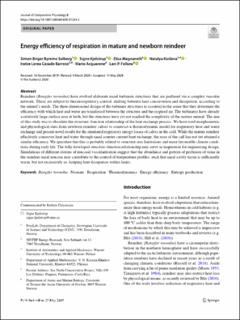| dc.contributor.author | Solberg, Simon Birger Byremo | |
| dc.contributor.author | Kjelstrup, Signe | |
| dc.contributor.author | Magnanelli, Elisa | |
| dc.contributor.author | Kizilova, Nataliya | |
| dc.contributor.author | Barroso, Iratxe Lorea Casado | |
| dc.contributor.author | Acquarone, Mario | |
| dc.contributor.author | Folkow, Lars | |
| dc.date.accessioned | 2020-09-10T09:00:02Z | |
| dc.date.available | 2020-09-10T09:00:02Z | |
| dc.date.created | 2020-06-08T08:19:34Z | |
| dc.date.issued | 2020 | |
| dc.identifier.citation | Journal of Comparative Physiology. B, Biochemical, Systemic, and Environmental Physiology. 2020, 190, 509–520 | en_US |
| dc.identifier.issn | 0174-1578 | |
| dc.identifier.uri | https://hdl.handle.net/11250/2677199 | |
| dc.description.abstract | Reindeer (Rangifer tarandus) have evolved elaborate nasal turbinate structures that are perfused via a complex vascular network. These are subject to thermoregulatory control, shifting between heat conservation and dissipation, according to the animal’s needs. The three-dimensional design of the turbinate structures is essential in the sense that they determine the efciency with which heat and water are transferred between the structure and the respired air. The turbinates have already a relatively large surface area at birth, but the structures have yet not reached the complexity of the mature animal. The aim of this study was to elucidate the structure–function relationship of the heat exchange process. We have used morphometric and physiological data from newborn reindeer calves to construct a thermodynamic model for respiratory heat and water exchange and present novel results for the simulated respiratory energy losses of calves in the cold. While the mature reindeer efectively conserves heat and water through nasal counter-current heat exchange, the nose of the calf has not yet attained a similar efciency. We speculate that this is probably related to structure-size limitations and more favourable climate conditions during early life. The fully developed structure–function relationship may serve as inspiration for engineering design. Simulations of diferent extents of mucosal vascularization suggest that the abundance and pattern of perfusion of veins in the reindeer nasal mucosa may contribute to the control of temperature profles, such that nasal cavity tissue is sufciently warm, but not excessively so, keeping heat dissipation within limits. | en_US |
| dc.language.iso | eng | en_US |
| dc.publisher | Springer Nature | en_US |
| dc.rights | Navngivelse 4.0 Internasjonal | * |
| dc.rights.uri | http://creativecommons.org/licenses/by/4.0/deed.no | * |
| dc.title | Energy efficiency of respiration in mature and newborn reindeer | en_US |
| dc.type | Peer reviewed | en_US |
| dc.type | Journal article | en_US |
| dc.description.version | publishedVersion | en_US |
| dc.source.pagenumber | 509–520 | en_US |
| dc.source.volume | 190 | en_US |
| dc.source.journal | Journal of Comparative Physiology. B, Biochemical, Systemic, and Environmental Physiology | en_US |
| dc.identifier.doi | 10.1007/s00360-020-01284-3 | |
| dc.identifier.cristin | 1814249 | |
| dc.relation.project | Norges forskningsråd: 257632 | en_US |
| dc.relation.project | Norges forskningsråd: 262644 | en_US |
| dc.description.localcode | Open Access This article is licensed under a Creative Commons Attribution 4.0 International License, which permits use, sharing, adaptation, distribution and reproduction in any medium or format, as long as you give appropriate credit to the original author(s) and the source, provide a link to the Creative Commons licence, and indicate if changes were made. The images or other third party material in this article are included in the article's Creative Commons licence, unless indicated otherwise in a credit line to the material. If material is not included in the article's Creative Commons licence and your intended use is not permitted by statutory regulation or exceeds the permitted use, you will need to obtain permission directly from the copyright holder. To view a copy of this licence, visit http://creativecommons.org/licenses/by/4.0/. | en_US |
| cristin.ispublished | true | |
| cristin.fulltext | original | |
| cristin.qualitycode | 1 | |

